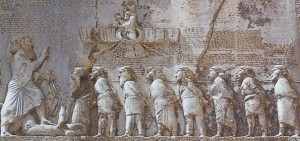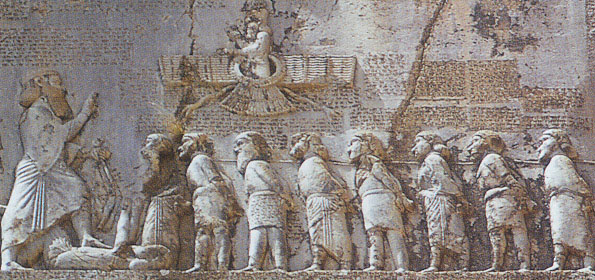The Bisotun site in Iran is approximately 30-32 kilometers to the northeast of the city of Kermanshah. The site is well known mainly because it is where Darius the Great () inscribed his declaration of victory over rivals, notably the pretender to the Achaemenid throne, Gaumata.

The sire is of special interest as its panel has been crucial in the scholarship leading to the discovery of the lost cuneiform handwritings of Old Persian, Elamite and Babylonian.
Bisotun is remarkable in that it representative of five distinct domains in ancient Iranian engineering namely masonry of the complex in 5 engineering fields: irrigation, stone craft, restoration, bridging, and industry. This was duly noted by Abdol Azim Amir Shahkarami (head of the Bisotun geophysical studies department in Iran) to the representative of ICOMOS (International Council on Monuments and Sites) on October 6, 2005.
Shahkarami also noted the following to the ICOMOS representative:
(1) the existence of ancient engineering activities behind the ancient structures and monuments indicating that the builders at Bisotun had a balanced view of the relationship between “Man, house, bridge, and nature.”
(2) The existence of two unique water systems at Bisotun. This is of interest as the inhabitants must have taken geomorphic factors into consideration as the region is prone to earthquakes and floods. The water channels are at least 12 meters deep indicating that the builders had an understanding of the geographic and geological factors at Bisotun.
(3) The Khosrow Bridge signifies the onset of urbanization at Bisotun with the Gamasyab River as the fluvial source.
The site however is much more than just an Achamenid site and is also host to
(1) A temple from the Median era (709-550 BC).
(2) A relic from the Seleucid era dated to probably 148-150 BC: the statue of Hercules or Herakles who is seen reclined on a lion; it was carved in 148 BC during the Seleucid period.
(3) A large number of relics from the Parthian era (247 BC-224 AD). The he Parthian reliefs are partly damaged, due to Safavid (post-Islamic) inscriptions as well as erosion through time. There are sections still standing on either side of the later carved (post-Achaemenid) inscription. More importantly, there are still figures visible which allows archeologists and historians to analyze Parthian era dress and military items. The right panels of the Parthian bas-reliefs display three scenes of Gotarzes II engaged in horseback riding (and spearing an enemy), being invested with kingship, and partaking in a religious (Zoroastrian or Mithraic) ritual. There are more Parthian structures next to these as well as the Hunters Cave on the three sides of a falling rock.
(4) A late Sassanian (early 7th century AD) rock surface that was smoothed down, however the main project was never completed. This was most likely intended as part of a Zoroastrian fire temple that was never completed.
ICOMOS recommended the registration of the site and its natural features as World Heritage sites and this was duly done by UNESCO on July 13 2006.




